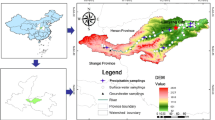Abstract
Groundwater residence time is an important indicator of hydrological cycle and essential for water resources development and utilization. In this paper, groundwater residence time in non-flood season, flood season and water year has been determined from daily streamflow hydrograph of ten hydrological stations in Wudinghe River Basin located in the middle reaches of the Yellow River Basin. Results have showed that: baseflow recession constant in Wudinghe River Basin ranges from 0.72 to 0.94 with a larger recession rate in flood season than that in non-flood season. Spatially, the recession rate of baseflow in loess area is the biggest, but is the smallest in the sandy area. The half-residence time of groundwater varies from 1.8 to 45.5 days while overall residence time of groundwater is between 34 and 342 days in different sub-basins of the Wudinghe River Basin. The annual average overall residence time of groundwater decreases from 117 days in the upper reaches to 73 days in the lower reaches.
Similar content being viewed by others
References
Anderson M G, Burt T P, 1980. Interpretation of recession flow. Journal of Hydrology, 46: 89–101.
Barnes B S, 1939. The structure of discharge-recession curves. Transactions of American Geophysical Union, 20: 721–725.
Burns D A, McDonnell J J, 1998. Effects of a beaver pond on runoff processes: Comparison of two headwater catchments. Journal of Hydrology, 205: 248–264.
Chen Xiande, 1996. Hydrology of Yellow River Basin. Zhengzhou: Yellow River Water Conservancy Press. (in Chinese)
Cheng Li, Liu Changming, 2000. Trends and concept of water resources and research on time of water availability. Advances in Water Science, 11(2): 153–158. (in Chinese)
Groundwater Research Group of the Loess Plateau Comprehensive Scientific Expedition Team, Chinese Academy of Sciences, 1990. Rational use of groundwater resources in Loess Plateau region. Beijing: Xueyuan Press. (in Chinese)
Hall F R, 1968. Base-flow recessions: A review. Water Resources Research, 4(5): 973–983.
Hewlett J D, Hibbert A R, 1967. Factors affecting the response of small watersheds to precipitation in humid areas. Sopper W E. Lull H W (eds.). Int. Symp. on Forest Hydrology, Oxford and New York: Pergamon, 275–290.
Kunkle G R, 1962. The baseflow duration curve, a technique for the study of groundwater discharge from a drainage basin. J. Geophys. Res., 67: 1543–1554.
Maloszewski P, Rauert W, Trimborn P et al., 1992. Isotope hydrological study of mean transit times in an alpine basin (Wimbachtal, Germany). Journal of Hydrology, 140: 343–360.
Maloszewski P, Zuber A, 1982. Determining the turnover of groundwater systems with the aid of environmental tracers, I. Models and their applicability. Journal of hydrology, 57: 207–331.
McDonnell J J, Rowe L, Stewart M, 2000. A combined tracer-hydrometric approach to assess the effect of catchment scale on water flow path, source and age. In: Leibundgut Ch, Schultz G, McDonnell J (eds.). Integrated Methods in Catchment Hydrology: Tracer, Remote Sensing and New Hydrometric Techniques, IAHS Publication 258. IAHS: Wallingford, 241–248.
McGuire K J, DeWalle D R, Gburek W J, 2002. Evaluation of mean residence time in subsurface waters using oxygen-18 fluctuations during drought conditions in the mid-Appalachians. Journal of Hydrology, 261: 132–149.
Nash J E, 1966. Applied flood hydrology. In: Thorn R B (ed.). River Engineering and Water Conservation Works. London: Butterworths, 63–110.
Nathan R J, McMahon T A, 1990. Evaluation of automated techniques for baseflow and recession analysis. Water Resources Research, 26(7): 1465–1473.
Rutledge A T, 1993. Computer programs for describing the recession of ground-water discharge and for estimating mean ground-water recharge and discharge from streamflow records. US Geological Survey Water Resources Investigations Report, 93–4121.
Rutledge A T, 1998. Computer programs for describing the recession of ground-water discharge and for estimating mean ground-water recharge and discharge from streamflow records: Update. US Geological Survey Water-Resources Investigations Report, 98–4148.
Smakhtin V Y, 2001. Low flow hydrology: A review. Journal of Hydrology, 240: 147–186.
Sujono J, Shikasho S, Hiramatsu K, 2004. A comparison of techniques for hydrographic recession analysis. Hydrological Processes, 18: 403–413.
Tallaksen T M, 1995. A review of baseflow recession analysis. Journal of Hydrology, 165: 349–370.
Vitvar T, Burns D A, Lawrence G B et al., 2002. Estimation of baseflow residence times in watersheds from the runoff hydrograph recession: method and application in the Neversink watershed, Catskill Mountains, New York. Hydrological Processes, 16: 1871–1877.
Vogel R M, Kroll C N, 1992. Regional geohydrologic-geomorphic relationships for the estimation of low flow statistics. Water Resources Research, 28(9): 2451–2458.
Whittenberg H, 1999. Baseflow recession and recharge as nonlinear storage processes. Hydrological Processes, 13: 715–726.
Wolock D M, Fan J, Lawrence G B, 1997. Effects of basin size on low-flow stream chemistry and subsurface contact time in the Neversink River watershed, New York. Hydrological Processes, 11: 1273–1286.
Zhu Ruirui, Li Lan, Wang Hao et al., 2004. Comparative study on the spatial variability of rainfall and its spatial interpolation methods. China Rural Water and Hydropower, 7: 25–28. (in Chinese)
Zhu X Y, Zhang X C, 1999. Study on Water Resources Change in the Yellow River. Zhengzhou: The Yellow River Water Resources Publishing House. (in Chinese)
Author information
Authors and Affiliations
Corresponding author
Additional information
Foundation: National Natural Science Foundation of China, No.40601015; No.40671031; National Key Technology R&D Program, No.2007BAC03A11
Author: Zhu Ruirui (1979–), Ph.D Candidate, specialized in hydrology and water resources.
Rights and permissions
About this article
Cite this article
Zhu, R., Zheng, H. & Liu, C. Estimation of groundwater residence time and recession rate in watershed of the Loess Plateau. J. Geogr. Sci. 20, 273–282 (2010). https://doi.org/10.1007/s11442-010-0273-z
Received:
Accepted:
Published:
Issue Date:
DOI: https://doi.org/10.1007/s11442-010-0273-z




